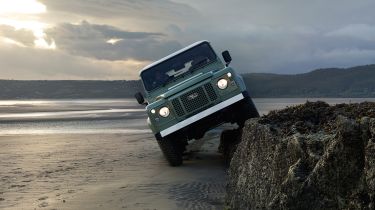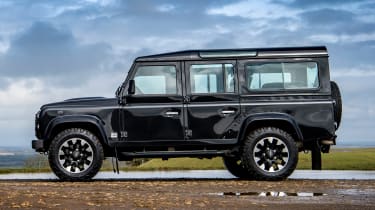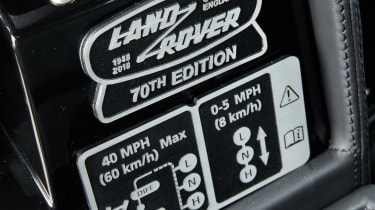Land Rover Defender SUV (1983-2016) - Interior & comfort
‘Utilitarian’ is probably the most polite way of describing the Land Rover Defender interior
The Defender’s agricultural nature affects comfort as much as performance. If you’re looking for an SUV or 4x4 that’s a quiet motorway cruiser, this is probably the last model we’d recommend. Thanks to its very old design, engine noise is excessive and a slab-sided body means wind noise is just as bad. The diesel engine makes an incredible racket, which is amplified when you rev it hard, and the Works V8 even more so – although the racket it makes is altogether more appealing
The suspension is designed to be sturdy and robust for off-road driving, but that doesn’t translate to on-road comfort. The Defender bounces over bumps, sending shockwaves through the interior, which in turn makes the dashboard creak and rattle in ways that would be unforgivable in just about any other passenger car.
Land Rover Defender dashboard
The Defender’s dated dashboard is designed to be rugged and utilitarian, rather than particularly luxurious. The interior in general is a long way from the opulence of the Range Rover, or even more modern offerings like the Land Rover Discovery Sport or Range Rover Evoque.
The dashboard itself is tall and almost completely slab-sided. All of the controls are right in the centre and made from plastics that don’t seem to have advanced in quality much since the nineties. The fan controls look particularly retro, causing us reminisce about cars like the Vauxhall Astra or Volkswagen Polo from 20 years ago. There is the odd luxurious touch, though, like an analogue clock, but overall the Defender is far from plush inside.
Equipment
The most basic Defender came with almost no luxuries at all – it doesn’t even have a radio, merely ‘preparation’ for one. Since this version is most likely to be used as a farm or commercial work vehicle, there’s very little need for them anyway. Next up was the County version, which adds a CD player with an MP3 player connection, but very little else.
More reviews
Late0build Defenders had a little more in the way of luxury, if you chose one of the rather pricey special editions. The Heritage Edition is finished in Grasmere Green paint (which harks back to the original Defender from 1948) and is equipped with painted steel wheels, aluminium inserts in the dashboard and perforated leather on the main controls. It also has ‘HUE 166’ graphics – referencing the registration number of the original pre-production Series 1 Land Rover, which was nicknamed ‘Huey’.
There’s also the Adventure Edition, which was designed to be even tougher than the standard car. It’s fitted with more underside protection, chunky off-road tyres, a black roof rack and loads of gloss-black touches.
The most expensive edition was the Defender Autobiography. Taking the Adventure spec as a starting point, it added Windsor leather seats, unique carpet mats and gloss-black and aluminium trim inside.
The Works V8 has rather more ornamentation, most notably special 18-inch diamond-turned alloy wheels and uncompromising BF Goodrich all-terrain tyres. There are LED headlights, and matched aluminium door handles and fuel filler cap, while Land Rover Classic can provide an almost limitless choice of paint colours if one of the eight regular shades doesn't take your fancy. The dashboard is trimmed in leather, and this is matched by the headliner. You get heated sports seats from famous specialists Recaro, but none of this can possibly disguise an interior that's barely changed in 50 years.














